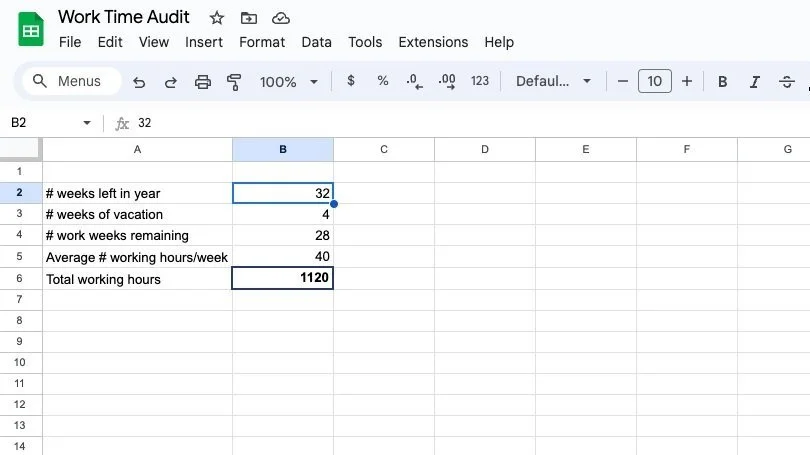Work Time Audit: Reclaim your schedule & get important work done.
There aren’t enough hours in the day…
If you're like the average charter school leader, you're clocking in over 60-hour work weeks. An outsider (or spouse) might assume that by working the equivalent of two full-time jobs, you should feel on top of your workload. But that couldn't be further from the truth! The feeling of perpetually running out of time isn't just a sentiment; it's a reality that nearly all leaders face.
A colleague recently shared a podcast episode by Jon Acuff called "Why you're always out of time and how to fix it." In the episode, Acuff lays out a formula to audit your time and then take meaningful action to regain control of your workload. We think this practice is dynamite and created a template to make the audit easy to perform. So, you can listen to the episode (1.5x speed) or read this article to audit your clock and get the work done that matters most.
Work Time Audit: Understanding Your Commitments
To audit our work time we will calculate your actual working hours this year, subtract your current commitments, and then balance your time budget. We suggest downloading our template first, then following steps 1-8.
Step 1: Calculate the Weeks Left in the Year [Time Tab, Cell B2]
Begin by taking stock of the time you have. How many weeks are left in the academic year? This gives you a foundation to build upon.
Step 2: Account for Vacation Time [Time Tab, Cell B3]
Unless you plan on burning out this year, you need to take breaks! Whether it's Thanksgiving, an anniversary, or winter break, tally up your vacation time.
Step 3: Subtract Vacation from Work Weeks [Time Tab, Cell B4]
This step offers a clearer picture of your true working weeks in the year.
Step 4: Define Your Desired Weekly Work Hours [Time Tab, Cell B5]
Acuff makes a poignant observation with the "Fish Bowl" analogy: just like a fish grows to the size of its bowl, our work tends to expand to fit the time we allocate. Decide on an average number of hours you want (or can) work each week.
Step 5: Calculate Your Yearly Work Hours [Time Tab, Cell B6]
Multiply your work weeks by your average weekly hours to determine the total hours you'll work in a year.
Step 6: Assign Hours to All Work Commitments [Work Commitments Tab, Project Brain Dump Tab]
List all your tasks, from projects to weekly meetings. Allocate rough hours to each. Don't forget to reserve 15-20% of your time for unplanned tasks, like emails, which can take about 90 minutes of your day.
Step 7: Determine Your Time Surplus or Deficit [Work Commitments Tab, Cell C24]
Subtract your total work commitment hours from your yearly work hours.
Step 8: Address the Deficit
If you have more commitments than hours, it's time to make adjustments.
Six Solutions to Fix Your Time Crunch
Confronting your time deficit can be daunting, but it’s a great alternative to always feeling behind. You can fix your time deficit with one or more of these solutions.
1. Work More Hours: This might seem like the most straightforward solution, but it's not usually feasible for school leaders with partners or families. If you're already clocking in 60+ hours a week, adding more might not be sustainable or healthy.
2. Cancel Commitments: As a school leader, you're pulled in myriad directions. But not all commitments hold equal importance. Prioritize tasks and consider dropping those that don't align with your big school objectives.
3. Ask for Help: It's a sign of strength, not weakness, to seek assistance. Whether it's hiring additional staff, a virtual assistant, or engaging in professional development, seeking help can lighten your load.
4. Delay Projects: Not every initiative needs immediate attention. Assess the urgency of your projects and consider postponing those that can wait, ensuring you give adequate time to the most pressing tasks.
5. Decrease the Quality (B- effort): This doesn't mean ditching responsibilities. Instead, it's about recognizing that not every task demands perfection. Sometimes, "good enough" is entirely sufficient and can save you invaluable time.
6. Create Systems for Greater Efficiency: Streamlined processes, technological tools, and clear protocols can drastically reduce the time spent on repetitive tasks. Investing in creating efficient systems can free up significant chunks of your schedule.
Complete Your Time Audit
Time management isn't just about squeezing more hours out of the day; it's about making the hours you have count. As Acuff identifies, most people shy away from taking a hard look at their commitments because they are afraid of what they’ll see.
But by being brave enough to evaluate your commitments and make necessary adjustments, you can pave the way for a more balanced, effective, and fulfilling leadership journey.
So, are you ready to take charge of your time?


